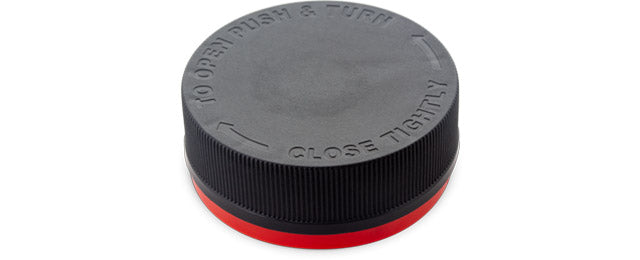CPG SEC. 450.500
Tamper-Resistant Packaging regulations covering most Over-The-Counter (OTC) products were published by the FDA in the FEDERAL REGISTER of November 5, 1982.
The regulations require that all over-the-counter (OTC) human drug products be packaged in tamper-resistant packaging (TRP). This includes cosmetic liquid oral hygiene products (mouthwash) and vaginal products (21 CFR 700.25), and contact lens solutions and tablets used to make these solutions (21 CFR 800.12). Dermatologics, dentifrices, insulin and throat lozenges are all excepted (21 CFR 211.132). All products require a minimum of one tamper-resistant feature.
The packaging must use an indicator or barrier to entry that is distinctive by design (such as an aerosol container), or must employ an identifying characteristic (a pattern, name, registered trademark, logo, or picture). Further, the regulations require a labeling statement on the container to alert the consumer to the specific tamper-resistant feature(s) used. The labeling statement is also required to be placed so that it will be unaffected if a TRP feature is breached or missing.
Manufacturers and packagers are free to use any packaging system as long as the tamper-resistant standard in the regulations is met. The TRP requirements are intended to assure that the product's packaging "can reasonably be expected to provide visible evidence to consumers that tampering has occurred."
The Agency evaluated currently available tamper-resistant packaging technologies and concluded that some technologies as designed or applied are not capable of meeting the requirements of the TRP regulations.
Examples of packaging technologies capable of meeting the TRP requirements are listed below. The use of one of these packaging technologies does not, by itself, constitute compliance with the requirements for a tamper-resistant package. Packaging features must be properly designed and appropriately applied to be effective TRP.
- FILM WRAPPERS. A transparent film is wrapped securely around the entire product container. The film must be cut or torn to open the container and remove the product. A tight "fit" of the film around the container must be achieved, e.g., by a shrink-type process. A film wrapper sealed with overlapping end flaps must not be capable of being opened and resealed without leaving visible evidence of entry.
The use of cellophane with overlapping end flaps is not effective as a tamper-resistant feature because of the possibility that the end flaps can be opened and resealed without leaving visible evidence of entry.
The film wrapper must employ an identifying characteristic that cannot be readily duplicated. An identifying characteristic that is proprietary and different for each product size is recommended.
Tinted wrappers are no longer acceptable as an identifying characteristic because of the possibility that their material or a facsimile may be available to the public. - BLISTER or STRIP PACKS. Dosage units (e.g., tablets or capsules) are individually sealed in clear plastic or plastic compartments with foil or paper backing.
The individual compartment must be torn or broken to obtain the product. The backing materials cannot be separated from the blisters or replaced without leaving visible evidence of entry. - BUBBLE PACKS. The product and container are sealed in plastic and mounted in or on a display card. The plastic must be torn or broken to remove the product. The backing material cannot be separated from the plastic bubble or replaced without leaving visible evidence of entry.
- HEAT SHRINK BANDS OR WRAPPERS. A band or wrapper is securely applied to a portion of the container, usually at the juncture of the cap and container. The band or wrapper is heat shrunk to provide a tight fit. The band or wrapper must be cut or torn to open the container and remove the product and cannot be worked off and reapplied without visible damage. The use of a perforated tear strip can enhance tamper-resistance.
Cellulose wet shrink seals are not acceptable. The knowledge to remove and reapply these seals without evidence of tampering is widespread.
The band or wrapper must employ an identifying characteristic that cannot be readily duplicated. An identifying characteristic that is proprietary and different for each product size is recommended.
Tinted bands or wrappers are no longer acceptable as an identifying characteristic because of the possibility that their material or a facsimile may be available to the public. - FOIL, PAPER, OR PLASTIC POUCHES. The product is enclosed in an individual pouch that must be torn or broken to obtain the product. The end seams of the pouches cannot be separated and resealed without showing visible evidence of entry.
- CONTAINER MOUTH INNER SEALS. Paper, thermal plastic, plastic film, foil, or a combination thereof, is sealed to the mouth of a container (e.g., bottle) under the cap. The seal must be torn or broken to open the container and remove the product. The seal cannot be removed and reapplied without leaving visible evidence of entry. Seals applied by heat induction to plastic containers appear to offer a higher degree of tamper-resistance than those that depend on an adhesive to create the bond.
Polystyrene foam container mouth seals applied with pressure sensitive adhesive are no longer considered effective tamper-resistant features because they can be removed and reapplied in their original state with no visible evidence of entry.
The Agency recognizes that technological innovations may produce foam seals that will adhere to a container mouth in a manner that cannot be circumvented without visible evidence of entry. Container mouth seals must employ an identifying characteristic that cannot be readily duplicated. An identifying characteristic that is proprietary and different for each product size is recommended. - TAPE SEALS. Tape seals relying on an adhesive to bond them to the package are not capable of meeting the TRP requirements because they can be removed and reapplied with no visible evidence of entry.
However, the Agency recognizes that technological innovations may produce adhesives which do not permit the removal and reapplication of tape seals. In addition, tape seals may contain a feature that makes it readily apparent if the seals have been removed and reapplied. Tape seals must employ an identifying characteristic that cannot be readily duplicated. - BREAKABLE CAPS. The container (e.g., bottle) is sealed by a plastic or metal cap that either breaks away completely when removed from the container or leaves part of the cap attached to the container. The cap, or a portion thereof, must be broken in order to open the container and remove the product. The cap cannot be reapplied in its original state.
- SEALED METAL TUBES OR PLASTIC BLIND-END HEAT-SEALED TUBES. The bottom of the tube is heat sealed and the mouth or blind-end must be punctured to obtain the product. A tube with a crimped end is capable of meeting the definition of a tamper-resistant feature if the crimped end cannot be breached by unfolding and refolding without visible evidence of entry.
- SEALED CARTONS. Paperboard cartons sealed by gluing the end flaps are not capable of meting the TRP requirements. However, the Agency recognizes that technological advances may provide sealed paperboard packages that meet the requirements of the TRP regulations.
- AEROSOL CONTAINERS. Aerosol containers are believed to be inherently tamper-resistant because of their design. Direct printing of the label on the container (e.g., lithographing), is preferred to using a paper label which could be removed and substituted
- CANS (BOTH ALL-METAL AND COMPOSITE). Cans may be composed of all metal or composite walls with metal tops and bottoms. The top and bottom of a composite can must be joined to the can walls in such a manner that they cannot be pulled apart and reassembled without visible evidence of entry. Rather than attaching a separate label, direct printing of the label onto the can (e.g., lithographing ) is preferred
CAPSULE SEALING TECHNOLOGIES
Technologies for sealing two-piece hard gelatin capsules are available that provide evidence if the capsules have been tampered with after filling. Such sealing technologies currently in use include sonic welding, banding, and sealing techniques employing solvents and/or low temperature heating. These examples are not intended to rule out the development and use of other capsule sealing technologies. Manufacturers may consult with FDA if they are considering alternative capsule sealing processes.
Sealed capsules are not tamper-resistant packages. They are required to be contained within a package system that utilizes a minimum of one TRP feature.
TRP LABELING STATEMENT(S)
- BOTTLE (CONTAINER) CAPS. In the past, some manufacturers have placed the TRP labeling statement on bottle caps. This practice is unacceptable in cases where it may be a simple matter to substitute another unlabeled bottle cap for the one with the tamper-resistant warning statement. Such an act could easily be accomplished without any apparent sign of tampering.
- PACKAGE INSERTS. The practice of placing the TRP labeling statement solely on the product's inserts is not acceptable. While package inserts may be a useful supplement for consumer education purposes, they are not acceptable in lieu of label statements.
- CARTON/CONTAINER (OUTER AND INNER). If the TRP feature is on an outer carton, the inner container (e.g., bottle) needs to bear a statement alerting the consumer that the bottle should be in a carton at the time of purchase. This policy applies only to situations where the inner container is so labeled that such a container might reasonably otherwise be displayed on the retail shelf without an outer carton.
- IDENTIFYING CHARACTERISTIC. When a TRP feature is required to have an identifying characteristic, that characteristic needs to be referenced in the labeling statement (e.g., "imprinted" neck band). It is recommended that the labeling statement specifically identify the characteristic (e.g., imprinted with XYZ on the neck band).
- TRP FEATURE(S). All required tamper-resistant features must be referenced in the labeling statement. When two tamper-resistant packaging features are used for unsealed two-piece hard gelatin capsules, both features must be referenced in the labeling statement. If one tamper-resistant packaging feature plus sealed capsules are used, the labeling statement must reference both the capsule seal and the tamper-resistant packaging feature.

